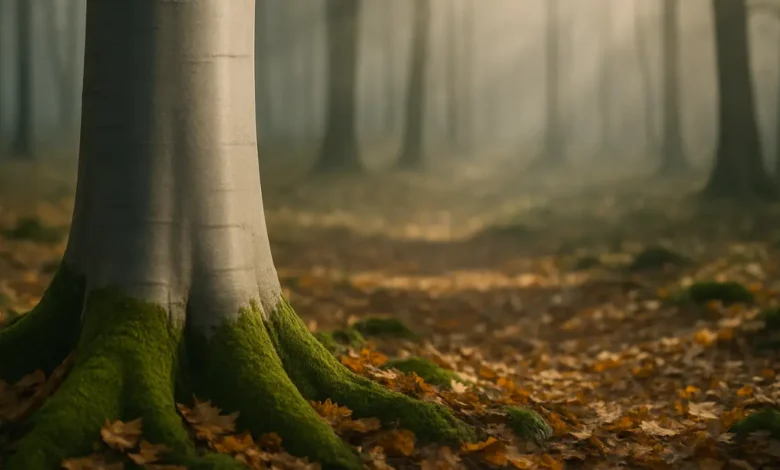The Beauty of the Tree with Smooth Gray Bark: Nature’s Silvery Masterpiece

Discover the beauty and science behind the tree with smooth gray bark — its types, symbolism, benefits, and care tips for gardeners and nature lovers.
Nature is full of subtle beauty, and among the most elegant sights in the forest is the tree with smooth gray bark. Unlike rough-barked oaks or peeling birches, these trees stand out with their satin-like trunks and graceful silhouettes. The smooth gray surface gives them a timeless charm that reflects both age and resilience. For nature lovers, landscapers, and gardeners, identifying or growing a tree with smooth gray bark opens a fascinating window into biodiversity, design, and sustainability.
Understanding the Tree with Smooth Gray Bark
When you walk through the woods, the tree with smooth gray bark is often the first to catch your eye. Its surface feels cool and almost metallic, yet it belongs to a living organism thriving in harmony with its surroundings. This characteristic bark isn’t just for looks—it plays a crucial role in protecting the tree from harsh weather, pests, and fungi.
A tree with smooth gray bark typically has a protective outer layer that doesn’t flake or crack easily. This helps prevent moisture loss and discourages insects from nesting. Many such trees, like the American Beech or the Southern Magnolia, maintain this sleek look for decades. Their bark acts as a natural defense mechanism, while also serving as a signature aesthetic element.
Why Bark Texture Matters in Nature
The texture of bark tells an intricate story about a tree’s adaptation and survival. A tree with smooth gray bark, for example, thrives in environments where flexibility and resilience are more beneficial than rugged protection. Smooth bark reflects sunlight efficiently, helping regulate internal temperature during hot seasons.
In contrast, trees with rough or deeply fissured bark rely on their thickness to protect from freezing temperatures and forest fires. Smooth gray bark signifies species that evolved in more temperate or humid regions, where the risk of bark-splitting from frost is minimal. It’s fascinating how these subtle differences define an entire ecological identity.
Popular Species of Trees with Smooth Gray Bark
There are several species that display this elegant characteristic. Each has its own habitat preferences, growth patterns, and ornamental value. Below is a table highlighting a few popular types of trees with smooth gray bark.
| Common Name | Scientific Name | Notable Features | Region |
|---|---|---|---|
| American Beech | Fagus grandifolia | Silky gray bark, dense foliage, edible nuts | Eastern North America |
| European Beech | Fagus sylvatica | Smooth silver-gray bark, majestic canopy | Europe |
| Southern Magnolia | Magnolia grandiflora | Glossy leaves, fragrant white flowers | Southeastern U.S. |
| American Hornbeam | Carpinus caroliniana | Muscular trunk shape, gray smooth bark | North America |
| Silver Maple | Acer saccharinum | Light gray bark, fast-growing | North America |
| Yellowwood | Cladrastis kentukea | Gray bark, fragrant white flowers | Central and Southern U.S. |
Each of these trees adds unique charm and structure to natural and landscaped spaces. The beech family, in particular, is renowned for its iconic gray bark, while magnolias contribute visual appeal through their glossy foliage and creamy blossoms.
The Aesthetic Value of Smooth Gray Bark in Landscaping
In landscaping design, bark texture and color play an underrated yet powerful role. A tree with smooth gray bark instantly adds elegance and contrast, especially when planted among shrubs or colorful foliage. The subtle gray hue pairs beautifully with greens, yellows, and reds—making it a neutral yet striking backdrop in any garden.
Landscapers often choose such trees for minimalist or modern outdoor spaces. Their smooth texture creates visual calmness, aligning with Zen-inspired gardens or clean architectural lines. Moreover, the gray tone reflects light differently throughout the day, creating dynamic shadows and highlights that evolve with the sun.
Ecological Importance of Trees with Smooth Gray Bark
Beyond their aesthetic charm, trees with smooth gray bark play critical ecological roles. They offer shelter for birds, small mammals, and beneficial insects. Many such species also support vital ecosystems through seed production and soil stabilization. For example, beech nuts provide essential winter food for wildlife, while hornbeams strengthen riverbank soils against erosion.
The gray bark also serves as a natural deterrent to certain parasites and fungi, reducing the tree’s dependency on chemical protection. These trees embody natural harmony—showing that beauty and function often coexist perfectly in the wild.
Identifying a Tree with Smooth Gray Bark in the Wild
Identifying a tree with smooth gray bark involves more than just color. You should observe the bark’s texture, branching pattern, leaves, and seasonal behavior. For instance, the American Beech’s bark is smooth, silvery-gray, and slightly mottled, while the American Hornbeam appears as if muscles are rippling beneath the surface of its trunk.
When hiking or exploring, run your fingers gently over the bark. Smooth species will feel waxy or cool to the touch. Take note of leaf shapes—beech leaves have pointed tips and serrated edges, whereas magnolia leaves are broader and leathery. Paying attention to these details will help you distinguish species with similar bark appearances.
Growing and Caring for Trees with Smooth Gray Bark
Planting a tree with smooth gray bark requires understanding its growing conditions. Most of these species prefer well-drained soil and partial to full sunlight. The beech tree, for example, grows best in loamy soil with consistent moisture, while the hornbeam tolerates both shade and wet soils.
Here are some essential care tips:
- Watering: Deep watering encourages strong root development. Avoid overwatering, as it may lead to root rot.
- Pruning: Regular pruning maintains shape and airflow. Smooth-barked trees can scar easily, so use clean, sharp tools.
- Fertilizing: Organic compost or slow-release fertilizers provide steady nutrients without chemical burn.
- Protection: Young trees should be protected from extreme frost and mechanical damage (e.g., lawn equipment).
The key to thriving growth lies in patience and proper site selection. Once established, these trees require minimal maintenance and can thrive for decades.
Symbolism and Cultural Meaning of Smooth Gray Bark Trees
Throughout history, trees with smooth gray bark have carried symbolic meanings. In many cultures, the beech tree is a symbol of wisdom, patience, and learning. Its pale bark was once used as a surface for writing in ancient Europe—hence the root of the word “book” (boc in Old English) comes from beech.
Gray bark symbolizes neutrality, balance, and endurance. In Feng Shui, gray represents stability and composure, making trees with gray trunks popular in spiritual gardens. Their serene presence evokes reflection, grounding, and calm energy—qualities increasingly sought in modern living spaces.
Differences Between Smooth and Rough Bark Trees
Understanding the contrast between smooth and rough bark is crucial for botanists and gardeners alike. Here’s a comparative overview:
| Feature | Smooth Gray Bark Trees | Rough Bark Trees |
|---|---|---|
| Surface Texture | Silky, metallic, or waxy | Coarse, flaky, ridged |
| Adaptation | Mild climates, moisture regulation | Harsh climates, fire resistance |
| Growth Habit | Flexible, often symmetrical | Dense and rugged |
| Examples | Beech, Hornbeam, Magnolia | Oak, Pine, Hickory |
Smooth gray bark often signifies resilience in calm conditions, whereas rough bark reveals adaptation to adversity. Yet both types are vital in maintaining biodiversity and ecological stability.
The Role of Bark in Tree Health
Bark isn’t just a covering—it’s the tree’s first line of defense. Beneath the smooth gray exterior lies a complex system of tissues responsible for nutrient transport and healing. When a tree is wounded, it secretes resins or sap to seal the area, preventing infection.
Smooth gray bark trees have evolved an interesting defense mechanism. Instead of forming deep ridges, they maintain elasticity to heal small cracks quickly. This helps protect from fungus and insect intrusion. Additionally, the gray color reflects sunlight, minimizing overheating during long summer days.
Common Myths About Trees with Smooth Gray Bark
Many people believe that smooth gray bark trees are more delicate, but that’s not entirely true. While they may appear fragile, these trees are often incredibly durable. The American Beech, for instance, can live for over 300 years under ideal conditions.
Another myth is that gray bark indicates disease or aging. In reality, it’s a natural pigment combination of tannins and minerals that creates the unique hue. The smooth surface also doesn’t necessarily mean the tree is young—some species retain that appearance throughout their lifetime.
How Climate Affects Bark Texture and Color
Climate directly influences bark evolution. In warmer, humid regions, trees with smooth gray bark dominate because their sleek surface helps shed moisture and discourage moss growth. In contrast, colder environments favor thicker, cracked bark that protects against frost.
Sunlight intensity also affects pigmentation. Trees growing in open fields develop lighter gray bark to reflect more light, while those in shaded forests often display darker hues. Soil pH and mineral content can subtly alter bark tones, creating stunning diversity even within the same species.
Trees with Smooth Gray Bark in Urban Settings
Urban landscapes increasingly favor trees with smooth gray bark due to their low maintenance and clean aesthetic. Beech, hornbeam, and magnolia varieties are frequently planted along boulevards, parks, and university campuses. Their uniform bark color complements modern architecture while offering shade and air purification.
Moreover, these trees tolerate moderate pollution and compacted soils better than many others. The absence of flaky bark means less mess on sidewalks, a small but practical advantage for city management. Their resilience and elegance make them perfect candidates for eco-friendly urban greening projects.
Wildlife Interactions with Smooth Gray Bark Trees
Although smooth bark might seem inhospitable for climbing animals, many species have adapted to it. Birds often use the upper branches for nesting, while insects burrow beneath the thin bark layers during certain life stages. Bats and tree frogs are known to cling to the subtle ridges of magnolia or beech trunks for resting.
However, the smoothness also means fewer crevices for pests like borers, which reduces infestations. The bark’s texture thus balances ecological interactions—offering shelter while limiting harm.
Interesting Facts About Trees with Smooth Gray Bark
- The American Beech was once a favorite carving surface for lovers who etched initials into its smooth gray bark.
- The European Beech can grow up to 150 feet tall, forming majestic canopies in old-world forests.
- Some magnolia species with smooth gray bark date back to prehistoric times, making them living fossils.
- The Hornbeam gets its nickname “musclewood” due to its sinewy, muscular-looking trunk texture.
These fun facts reveal how closely tied these trees are to human history and natural evolution.
Expert Gardening Tip: Pairing with Other Plants
When designing a garden, pairing a tree with smooth gray bark with complementary plants enhances visual harmony. Try combining it with:
- Deep green evergreens for year-round contrast
- Flowering shrubs like azaleas for color layering
- Ground covers such as hostas or ferns to soften the base
Avoid overcrowding, as these trees need space for roots to breathe and for their stunning trunks to remain visible.
Quotes About Nature’s Subtle Beauty
“The beauty of a tree lies not in its height or color, but in the quiet grace of its bark.”
— Unknown
“Gray bark is nature’s silver—silent, smooth, and enduring.”
— Botanical Journal of Aesthetics
These quotes encapsulate the meditative and enduring allure of smooth gray bark trees, reminding us to appreciate their understated elegance.
Frequently Asked Questions
What kind of tree has smooth gray bark?
Common examples include the American Beech, European Beech, Hornbeam, and certain Magnolias. These trees share similar bark textures but vary in size, habitat, and foliage.
Why is some bark gray and smooth?
The smooth gray appearance results from a combination of thin outer layers, tannins, and environmental factors that limit fissure formation. It’s an adaptive trait for moderate climates.
Is smooth gray bark a sign of a healthy tree?
Generally, yes. Smooth bark indicates the tree’s surface hasn’t been damaged by pests or weathering. However, always check for discoloration or cracks that might indicate disease.
Can I grow a tree with smooth gray bark in my garden?
Absolutely. Many species like the American Beech and Hornbeam thrive in well-drained soil with regular sunlight. They’re low-maintenance once established.
Do smooth bark trees attract fewer insects?
Yes, their sleek texture provides fewer hiding spots for harmful insects, making them more resistant to infestations compared to rough-barked trees.
Conclusion
The tree with smooth gray bark stands as a living masterpiece of nature’s design—graceful, protective, and enduring. Its soft metallic sheen adds sophistication to forests, gardens, and cityscapes alike. From the majestic beech to the ornamental magnolia, each smooth-barked tree tells a story of adaptation and balance.
Whether you’re an arborist, gardener, or nature enthusiast, understanding these trees deepens your appreciation of biodiversity and the quiet power of resilience. In a world that often celebrates loud colors and flamboyant blossoms, the tree with smooth gray bark teaches us the beauty of subtlety and strength.





